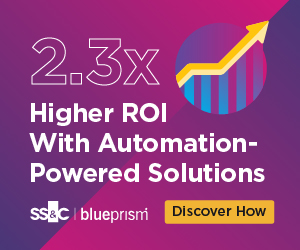
A Guest Perspective by Jerry Adach, Manager of Web, Data Access and Automation, Ellis Medicine.
Ellis Medicine is a 438-bed community and teaching healthcare system serving New York’s Capital Region–the metropolitan area surrounding Albany. It comprises four campuses–Ellis Hospital, Ellis Health Center, Bellevue Woman’s Center and Medical Center of Clifton Park–five additional service locations, more than 3,300 employees and more than 700 medical staff, offering inpatient and outpatient services, including cardiac, cancer, emergency, neuroscience and women’s services.
Like any healthcare organization, many of our processes and workflows require manual attention–sometimes by highly trained medical personnel, whose efforts are sorely needed elsewhere.
RPA Succeeds in a Test Case
About two years ago, Ellis Medicine needed to integrate a new Point of Sale (POS) system into its existing infrastructure. It was a very complex task, which led us to consider Robotic Process Automation (RPA) for the first time as an organization.
The task was sent to the Web, Data Access and Automation team for review. It would require sending employee opt-in and opt-out data from an internal application to the POS provider via SFTP in a specific format. It also required receiving, via email, a nightly transaction file that would have to be reformatted to a specific set of criteria; then send the data as a comma separated flat file to the HR system via SFTP. This data also needed to be stored in a SQL Server database for reporting purposes. This entire process needed to be completed every night.
After the review and after considering other alternatives, we concluded that the only reasonable solution was RPA. The entire workflow was built in just a few days with appropriate error handling.
Successfully automating that process demonstrated to senior leadership that RPA could be adopted at Ellis Medicine more comprehensively.
Building Out a Comprehensive RPA Program
Ellis Medicine uses RPA for most of its ETL work, file deliveries to third parties with encryption, and pulling data from many different sources (including third-party web sites) into the enterprise MSSQL Server. Currently, the team is aggressively working on interaction workflows in Soarian Financials, the primary financial system.
Regarding Soarian Financials, the Web, Data Access and Automation team recently automated the extremely cumbersome process of generating transaction files for bad debt recall. This process had 26 pages of instructions for manual completion. The RPA workflow was created in just a few days and has been running flawlessly for several weeks now.
Another success story was automating manual journal entries in our accounting office. This was a very tedious task that required many hours per week by skilled accountants. They had to work from Excel documents posting entries into an old (green screen) accounting system. The accountants couldn’t even copy and paste, which lead to errors.
The Web, Data Access and Automation team looked at the process and decided it was a great candidate for automation. This workflow took about a week to develop due to the complexity and advanced error handling. Since this interactive workflow was automated a year ago, 2,100 journal entry files were processed. Each file contains multiple entries. The accountants at Ellis Medicine no longer perform journal entries.
There are many, many more examples of what Ellis has done with RPA, both background running workflows and interactive workflows. Since the first pilot two years ago, we now have approximately 50 RPA workflows in production.
Lessons Learned
There are a few things Ellis learned along the way. Error handling must be robust. Always prepare for failure. Also, the proper infrastructure needs to be created, especially if you want to build interactive workflows. Ellis has one primary server for much of the background workflows and utilizes multiple VMs for interactive workflows.
The Web, Data Access and Automation team at Ellis Medicine has oversight of the RPA platform. This has proven extremely advantageous. Members of this team have always been viewed as “problem solvers” and now they have a new tool to go to. The fact that this team has access to so much data and can create line-of-business data-driven web applications, along with a robust SharePoint environment, positions it for success in the RPA space and can provide real added value back to Ellis Medicine.
The next step is to partner with the organization’s Strategic Projects and Performance Improvement department. This will allow Ellis to take RPA to the next level and give them a competitive advantage.
Tools in Use by Ellis
[um_loggedin]
Most mainstream RPA platforms are very similar, but not the same. Each has strong points and weak points. Using more than one can sometimes make sense.
At Ellis, we use Automate Enterprise by HelpSystems as the primary platform and Winautomation by Softomotive as a secondary solution.
In some cases, Winautomation handles very large data set much more quickly. Since Winautomation allows you to create stand-alone executables, those executables then can be incorporated into larger workflows built with Automate Enterprise.
[/um_loggedin]
[um_loggedout]
[/um_loggedout]


